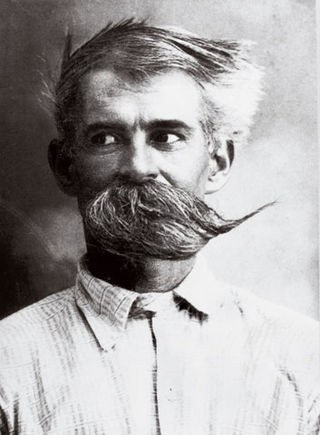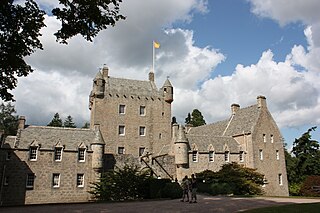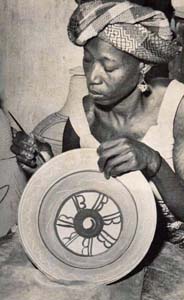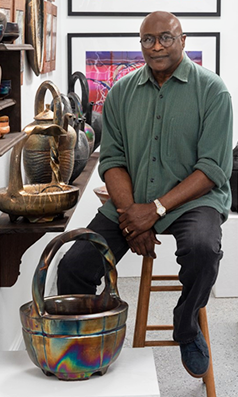Related Research Articles

Ceramics of Indigenous peoples of the Americas is an art form with at least a 7500-year history in the Americas. Pottery is fired ceramics with clay as a component. Ceramics are used for utilitarian cooking vessels, serving and storage vessels, pipes, funerary urns, censers, musical instruments, ceremonial items, masks, toys, sculptures, and a myriad of other art forms.

George Edgar Ohr was an American ceramic artist and the self-proclaimed "Mad Potter of Biloxi" in Mississippi. In recognition of his innovative experimentation with modern clay forms from 1880 to 1910, some consider him a precursor to the American Abstract-Expressionism movement.

Peter Voulkos was an American artist of Greek descent. He is known for his abstract expressionist ceramic sculptures, which crossed the traditional divide between ceramic crafts and fine art. He established the ceramics department at the Los Angeles County Art Institute and at UC Berkeley.

Studio pottery is pottery made by professional and amateur artists or artisans working alone or in small groups, making unique items or short runs. Typically, all stages of manufacture are carried out by the artists themselves. Studio pottery includes functional wares such as tableware and cookware, and non-functional wares such as sculpture, with vases and bowls covering the middle ground, often being used only for display. Studio potters can be referred to as ceramic artists, ceramists, ceramicists or as an artist who uses clay as a medium.

Cawdor Castle is a castle in the parish of Cawdor in Nairnshire, Scotland. It is built around a 15th-century tower house, with substantial additions in later centuries. Originally a property of the Calder family, it passed to the Campbells in the 16th century. It remains in Campbell ownership, and is now home to the Dowager Countess Cawdor, stepmother of Colin Campbell, 7th Earl Cawdor.
Colin Robert Vaughan Campbell, 7th Earl Cawdor, DL is a Scottish peer, landowner, and architect.
John Duncan Vaughan Campbell, 5th Earl Cawdor, TD, styled Viscount Emlyn between 1911 and 1914, was a Scots-Welsh nobleman.

The Google Book is an illustrated book of children's verse by Vincent Cartwright Vickers.

Svend Bayer is a Danish-British studio potter described by Michael Cardew as "easily my best pupil."

Ladi Kwali or Ladi Dosei Kwali, OON NNOM, MBE was a Nigerian potter, ceramicist and educator.

Ceramics in Mexico date back thousands of years before the Pre-Columbian period, when ceramic arts and pottery crafts developed with the first advanced civilizations and cultures of Mesoamerica. With one exception, pre-Hispanic wares were not glazed, but rather burnished and painted with colored fine clay slips. The potter's wheel was unknown as well; pieces were shaped by molding, coiling and other methods,

James C. Watkins was born in Louisville, Kentucky, in 1951 and raised in a farming family in Athens, Alabama. He is a ceramic artist living in Lubbock, Texas who has worked with clay for over 40 years. He is known for his large scale double-walled ceramic vessels and laser cut porcelain substrate tiles. He is recognized for his textured surfaces, created by using alternative firing techniques. His porcelain substrate tiles are fumedArchived 2014-09-07 at the Wayback Machine with stannous chloride and multi-fired using ferric chloride, gold and platinum luster to achieve colorful surfaces.
Jack Doherty is a Northern Irish studio potter and author. He is perhaps best known for his vessels made of soda-fired porcelain. He has been featured in a number of books, and his work has been exhibited widely in both Europe and North America. Articles of his have appeared in various pottery journals and he has been Chair of the Craft Potters Association.

Ian Broun Sprague (1920–1994) was an Australian twentieth-century studio potter, ceramic sculptor and graphic artist. Delayed by the Second World War and a false start in architecture, he spent (broadly) his forties adapting Australian domestic pottery to a Japanese aesthetic of contemplative use; his fifties as a sculptor in two- and three-dimensional pottery; his sixties and seventies making landscape works on paper.
Dick Lehman is an American ceramics artist based in Indiana. Dozens of articles and photos featuring his techniques and insights have appeared in periodicals and books on ceramic art since 1985, including 34 articles in U.S.-published Ceramics Monthly, the largest circulating magazine in the field, plus articles in 11 other international periodicals.
Israeli ceramics are ceramics designed either in Mandatory Palestine or Israel from the beginning of the 20th century. In additional to traditional pottery, in Israel there are artists whose works were created in an industrial environment. Until the late 1970s there existed in Israel a local tradition that emphasized the local values of nature as an expression of Zionist identity. From the 1980s artistic expressions that sought to undercut this tradition began to appear in the works of Israeli artists, who combined ceramics with other artistic media and with personal, critical agendas.
Karl Martz was an American studio potter, ceramic artist, and teacher whose work achieved national and international recognition.

Jennifer Elizabeth Lee is a Scottish ceramic artist with an international reputation. Lee's distinctive pots are hand built using traditional pinch and coil methods. She has developed a method of colouring the pots by mixing metallic oxides into the clay before making. Her work is held in over forty museums and public collections worldwide, including the Metropolitan Museum of Art in New York, the Philadelphia Museum of Art, the Los Angeles County Museum and the Victoria and Albert Museum. In 2018 Lee won the Loewe Craft Prize, an award initiated by Jonathan Anderson in 2017. The prize was presented to her at an awards ceremony at The Design Museum in London.

James "Jim" Sankowski was an American ceramic artist. He was a studio potter known for creating high-fired porcelain pottery that has been described as functional, decorative, and contemporary.
John Reeve was a Canadian studio potter.
References
- ↑ "The poetics of potter james campbell". www.thefreelibrary.com. Retrieved 23 December 2019.
- ↑ "James Campbell". www.britainisnocountryforoldmen.com. Retrieved 23 December 2019.
- ↑ "James Campbell - Ceramicist". www.guildcraft.org.uk. Retrieved 23 December 2019.
- ↑ V.C.Vickers, Andrew Brain & Gareth Monger (2019). The Google Book. Ecen Books.